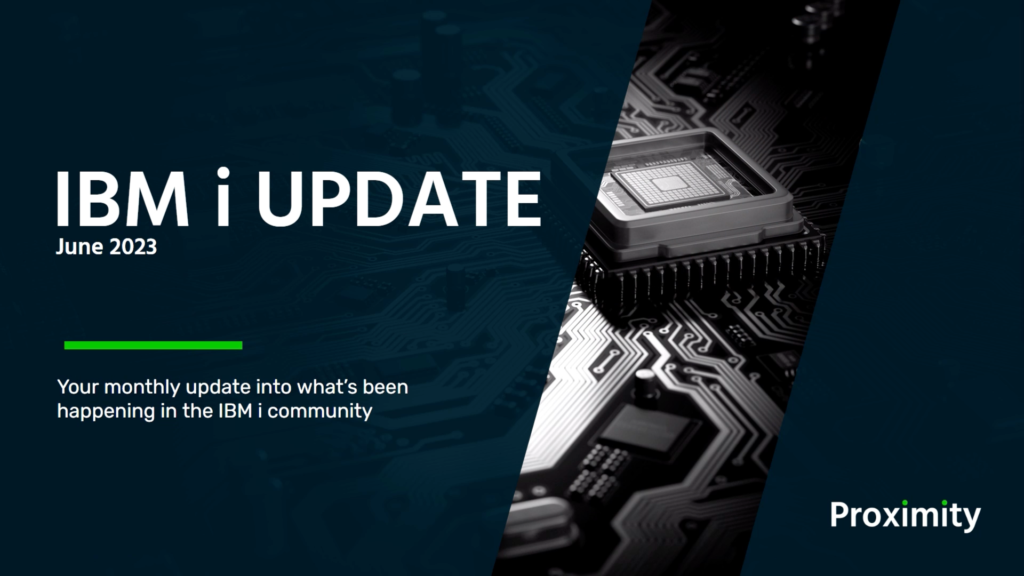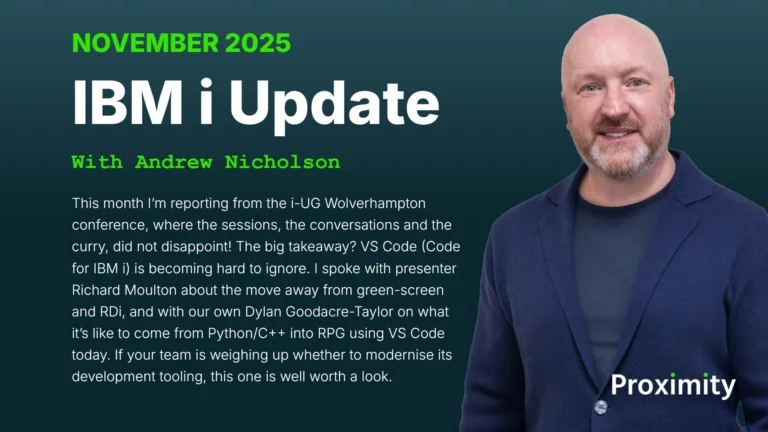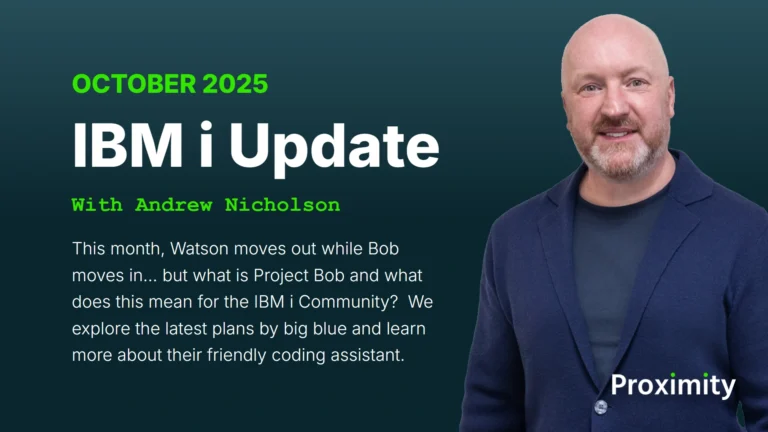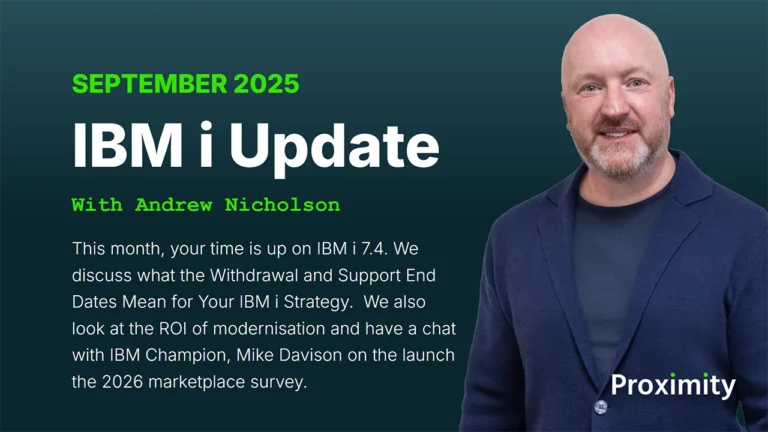Welcome to your #IBMi update, your monthly update into what’s been happening in the IBM i community, with Andy Nicholson from Proximity. You can watch the video below or read the full article underneath.
Watch the Video:
Full Article:
i-Power, Common Europe and a 35th Birthday!
Your monthly update into what’s been happening in the IBM i community with Andy Nicholson.
This month, as a change of pace, we’ll provide a review and ‘quick’ insight into what it’s like to attend both the i-UG Power event in the UK plus COMMON Europe, this year hosted in Prague… oh, and there’s also small matter of a 35th birthday too.
You can watch the video above or read the blog post below…
Now, at the beginning of June we enjoyed the two day i-Power event in Northampton, inside and in the main expo hall, we found vendors representing all aspects of ‘i’ from modernisation to managed services.
The speakers were equally as varied with security expert, Carol Woodbury, hosting workshops on how to build and maintain security on the IFS and Redbooks author, Brigitta Hauser discussing JSON and web services.
But there was so much more to digest other than these with topics including cloud deployment, modernisation, Open Source and more.
But, with this being the 35th birthday of IBM i, it was Scott Forstie, who’s keynote speech on the, ‘35 things I love about IBM i’ that provided the highlight.
Now, I won’t regurgitate his entire presentation, I’ll just pick 6 from the 35…
First on the list was that IBM i was a platform built for business. Scott went on to explain that, unlike other operating systems (Microsoft wasn’t named) that have been ‘tinkered with’ to support the enterprise, IBM i was built from the ground up with all the components inherent in the OS to make it the perfect transactional platform.
Expanding on this, Scott went on to speak about the architecture that enables IBM i to be perfect for business… these include it’s object oriented architecture, wealth of language runtimes utilising the Portable Application Solutions Environment (or PASE for short) and a plethora of integration opportunities too.
Now, as Scott is the Db2 database architect and SQL evangelist, it came as no surprise that SQL popped up a couple of times with both the SQL Query engine being a cut above classic query and the ever increasing list of SQL enhancements native to i.
Scott also picked IBM Navigator for i, with it’s modern UI for accessing, monitoring and managing your IBM i.
The multithreaded abilities since 1996 for native support and 1999 for native IBM i multithreading on DB2. And finally, continuing with the ever evolving nature of the OS, the support of REST and RESTful APIs on the platform too.
He also recommended Scott’s tutorial pages that includes over 50 videos and much more here.
Scott even managed to provide a way to use RESTful services for Dad jokes…
And the frivolities didn’t end there as the entertainment extended into the evening at the gala dinner.
With a variety of entertaining guest speakers, great food and, as a final presentation by the national museum of computing a bit of a brain teaser to get the grey matter moving.
But the undoubted star of the show was, cake! The specially commission 35th Birthday Cake for IBM i no less. Happy birthday IBM i!
i-Power was a wonderful event and on it’s completion, it was only a couple of days later that I was travelling to Prague for the Common European Congress. Hosted at the Vienna House Diplomat Hotel, Common Europe was a three day event that took over the entirety of the second floor.
Perhaps the most anticipated speech of the first morning was by Steve Sibley, the VP and IBM Power Production Manager.
He spoke on Digital Transformation but it was his words regarding the IBM i community that bought him the room…
He started by praising the IBM i community be explaining that, “He cannot iterate enough that how the community of IBM i, is IBM i.” He went on to say that, “IBM i is always held up as one of the prime examples inside IBM.”
Continuing with this theme, later in the presentation he introduced a video of Tom McPherson, the VP of IBM Power Systems.
In celebrating the 35th anniversary of IBM i, during his speech, Tom explained, “My experience… is that it has the highest client passion that i’ve ever seen.
Like, tattoo level client passion… and I’d venture to say that it’s the most loved platform we’ve had in the company.”
Indeed, Steve went on to demonstrate the ‘tattoo levels of client passion’ by showing a few shots of IBM i related tattoos within the community and even went on to hand out ‘35th anniversary, i love IBM i’ tattoo transfers to the willing audience.
Speaking of which, the auditorium was packed with around 400 hundred people in the room hanging on his every word.
There were so many interesting sessions to attend but for this blog, I’ll pick out two that piqued my interest. The first of which involved the hot topic of AI. This session was hosted by Remain Software CTO Wim Jongman and he discuss using ChatGPT with RDI.
Wim first gave a brief history of AI, then went through a practical exercise in real-time of creating a simple Java program using ChatGPT.
Further on, he explained how ChatGPT can support your development activities, from crafting SQL instructions to creating and decoding legacy code.
Here he introduced a dedicated API for RDi Eclipse that allows you to write code faster and more efficiently all within the one GUI. It was all very impressive.
The other vendor presentation I’ll feature was the Web language shootout by Alan Seiden, principle of Seiden group.
Alan provided an unbiased opinion on the open source web languages choices for API and web development.
His parameters for qualification were threefold. 1, the language could provide and consume API services. 2, the language could drive web applications, and 3, the language can call and be called by both RPG and COBOL.
Now, I encourage you to review his presentation in its entirety , but the three qualifying languages were PHP, possible the most popular web language on the planet, Python the most modern and clean and Node.JS, an efficient javascript runtime.
When looking at each language he applied some objective criteria in which you should use to select the language that right for your business.
These included the stability and support of the language, it’s longevity – not just on how long it’s been around but how well established it is too, any ‘superpowers’ it has – or, what’s it REALLY good at and the real litmus test, how simple it is to great a ‘hello world’ script.
Alan went onto explain that the rate of change in a language and stability are two opposing forces. Considerations therefore should be made to strike the correct balance for your business that provide the correct amount of certainty and longevity of code.
Alan left the decisions on what language was appropriate to the audience but went through some of the considerations.
With PHP, you’d enjoy the most established web language on the IBM i with a wealth of support, repositories and frameworks to choose from with a continually growing community.
Python is a dependable, clean language with exciting prospect but does have some compatibility issues if you’re looking to push the envelope.
Similarly with Node.js this is stable but still evolving but could be a favourite if you’re familiar with Java script already.
And this discussion hosted by Alan and the one previous by Wim are just two examples in what was a packed agenda available for delegates to attend.
Many of the presentations are now available on the Common Europe website (comeur.org) so please do go and check it out…
On the final evening of the expo, delegates were invited to Municipal House in the centre of Prague for an evening of culture. Here we were greeted by a champagne reception, a tour of the historic building and divine music by concert pianists… My thanks to Igor, his pianist daughters and the event team for organising such a delightful evening.
Before I wrap up the review one last snippet from the second keynote speech. Steve Will introduced Bill Starke, the Chief Architect for Power Processors at IBM.
He provided a history of Power and gave some insight into the future too, but it was his words on the fact that, comparatively speaking – IBM i is still a young platform that got the most applause…
Finally, conferences always have goodie bags for delegates. At i-UG we received a rather nice backpack with the usual advertisements and a good quality brochure while common Europe provided a tote bag but in addition to the brochure, also provided a t-shirt.
And that’s your IBM i update for June 2023 – a bit different from usual but I hope I gave you a ‘flavour’ on what it was like to attend or a good recap if you where there? Back to business next month but until then, catch more of this series on our blog using the link below.





